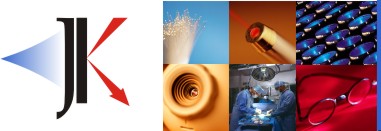
| |
| Home |
| About JKC |
| Coating Library |
| Designs |
| Materials |
| Designer FYI |
| Classes |
| Links |
| Contact Us |
Color Mirrors
Red Orange Yellow Green
Blue Pink
For all of the designs mentioned on this page, the following are used:
H = QWOT of high index material, or TiO2 (nH = 2.4 @ 550nm)
L = QWOT of low index material, or SiO2 (nL = 1.46 @ 550nm)
and, the substrate is glass (nS = 1.52 @ 550nm)
(where the QWOT is centered at l=550nm)
The red mirror is one of the hardest to produce a
nicely saturated color. It is important for the designer to produce a steep slope
for the rejection band and reduced ripple in the pass band. The designer can
start with a short wavelength pass filter design:

![]()
Due to the amount of ripple in the short wavelength pass band, the color cannot reach a true red. Instead, this mirror is more orange-reddish. This particluar mirror would measure to the following CIE 1931 chromaticity coordinates under the illumination listed:
| Illuminant | Illuminant C | 3200K (tungsten-halogen) |
| x/y | .580/.355 | .632/.349 |
| Dominant l | 602nm | 608nm |
A design technique that minimizes the amount of ripple in the pass band was taken from Reference 1, page 210. The design works off of the principle where one can reduce reflectance by using a series of quarter-wave layers with refractive indices in steady progression from one index medium to another. These quarter-wave layers can be represented by a series of symmetrical periods in an LHL fashion. This design is meant to match air from one side of the stack to the other. The design is as follows:


where,
| Period | Equivalent Index |
| I | 0.976 |
| II | 0.802 |
| III | 0.779 |
| IV | 0.871 |
| V | 0.966 |
When combining the five periods, this design has a
total of 17 layers.
The color performance of this red mirror design is as follows:
| Illuminant | Illuminant C | 3200K (tungsten-halogen) |
| x/y | .623/.301 | .668/.312 |
| Dominant l | 627nm | 624nm |
The design for the red mirror above can be incorporated for a sharp orange mirror as well. The red design layer thicknesses would need to be scaled by 90% to produce:

![]()
The color performance of this orange mirror design is as follows:
| Illuminant | Illuminant C | 3200K (tungsten-halogen) |
| x/y | .541/.439 | .573/.420 |
| Dominant l | 586nm | 591nm |
Once again, the design for the red mirror above can be incorporated for
a sharp orange mirror as well. The red design layer thicknesses would need to be
scaled by 84% to produce:

![]()
The color performance of this yellow mirror design is as follows:
| Illuminant | Illuminant C | 3200K (tungsten-halogen) |
| x/y | .468/.508 | .514/.474 |
| Dominant l | 575nm | 581nm |
![]() These sections are currently under
construction
These sections are currently under
construction